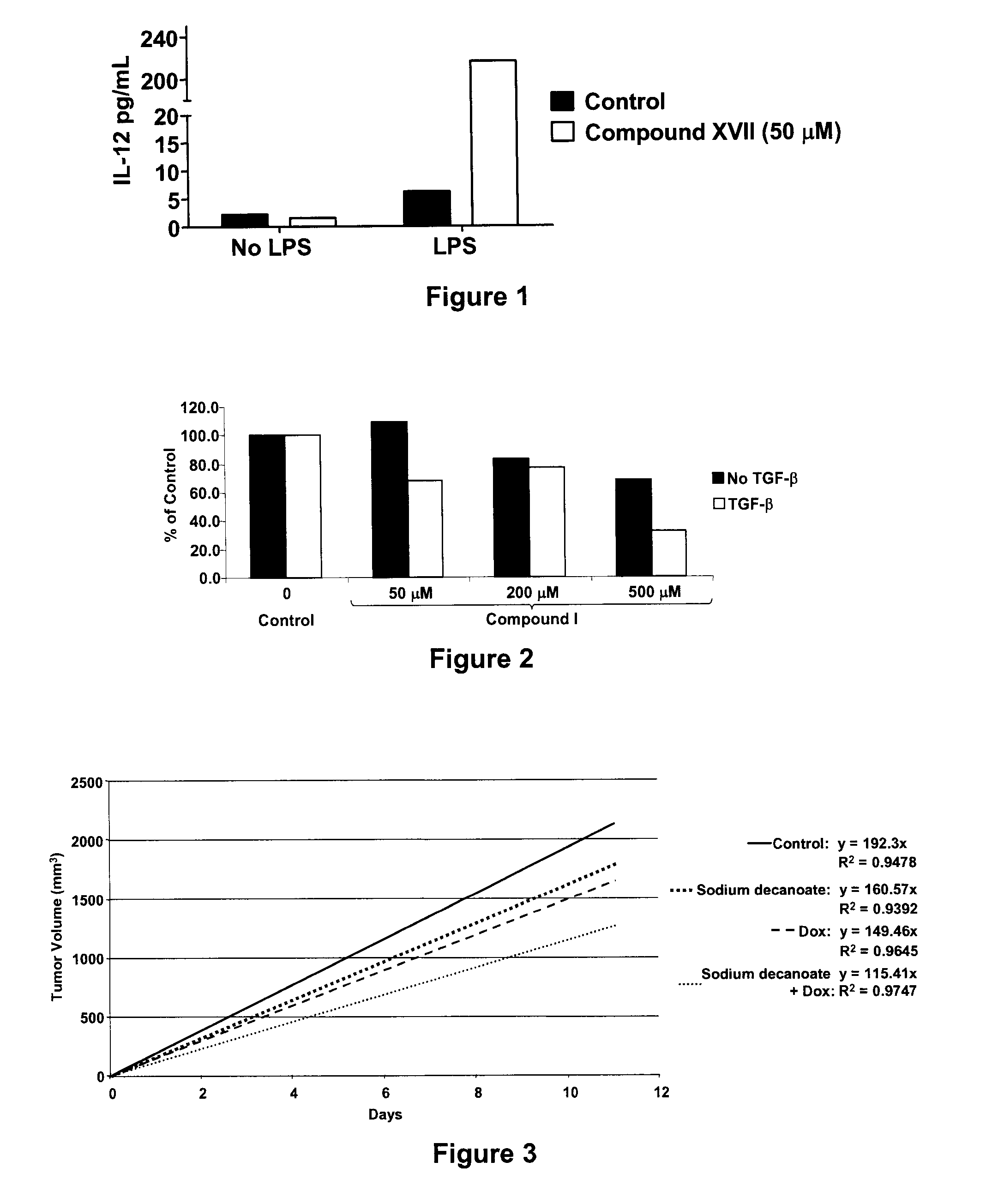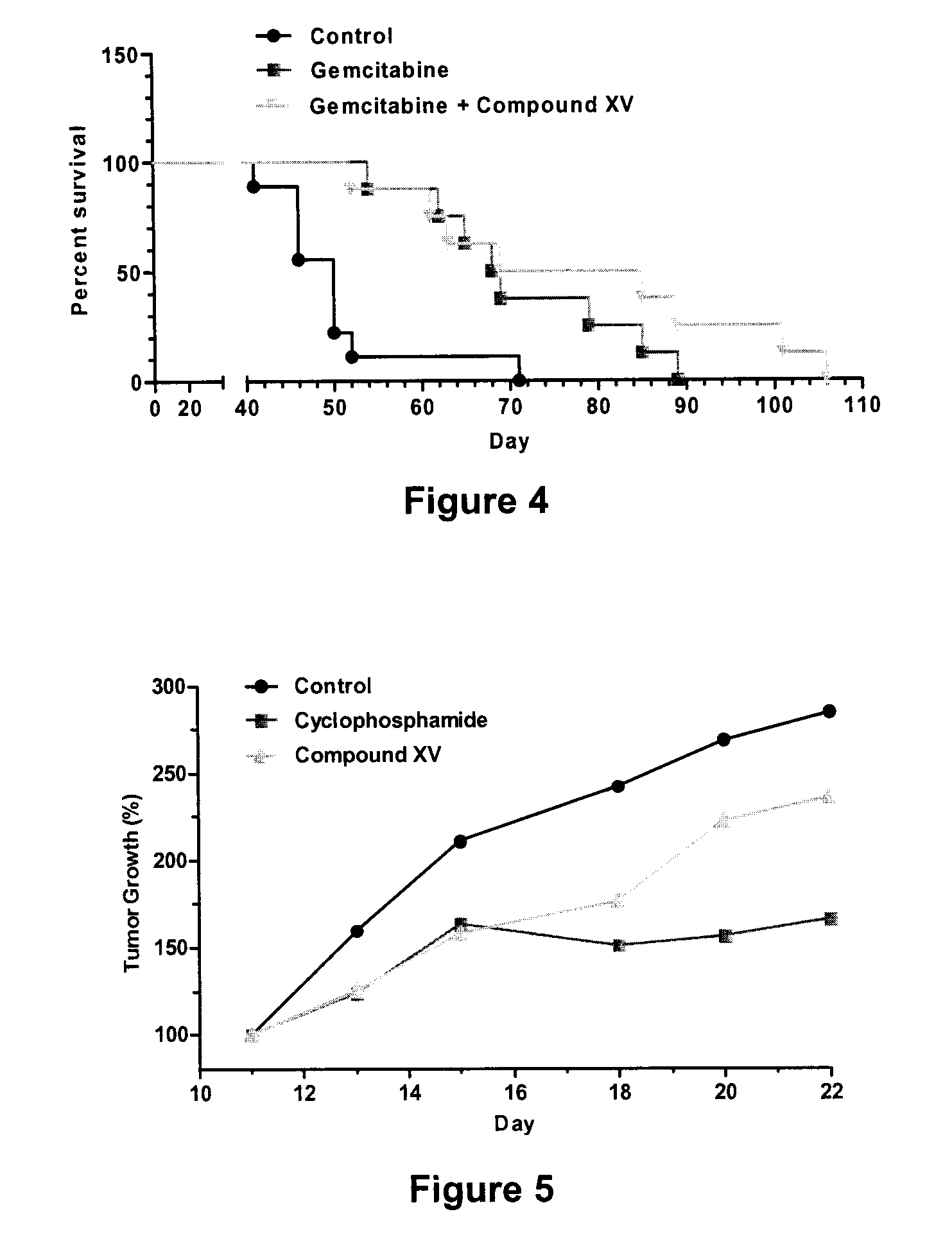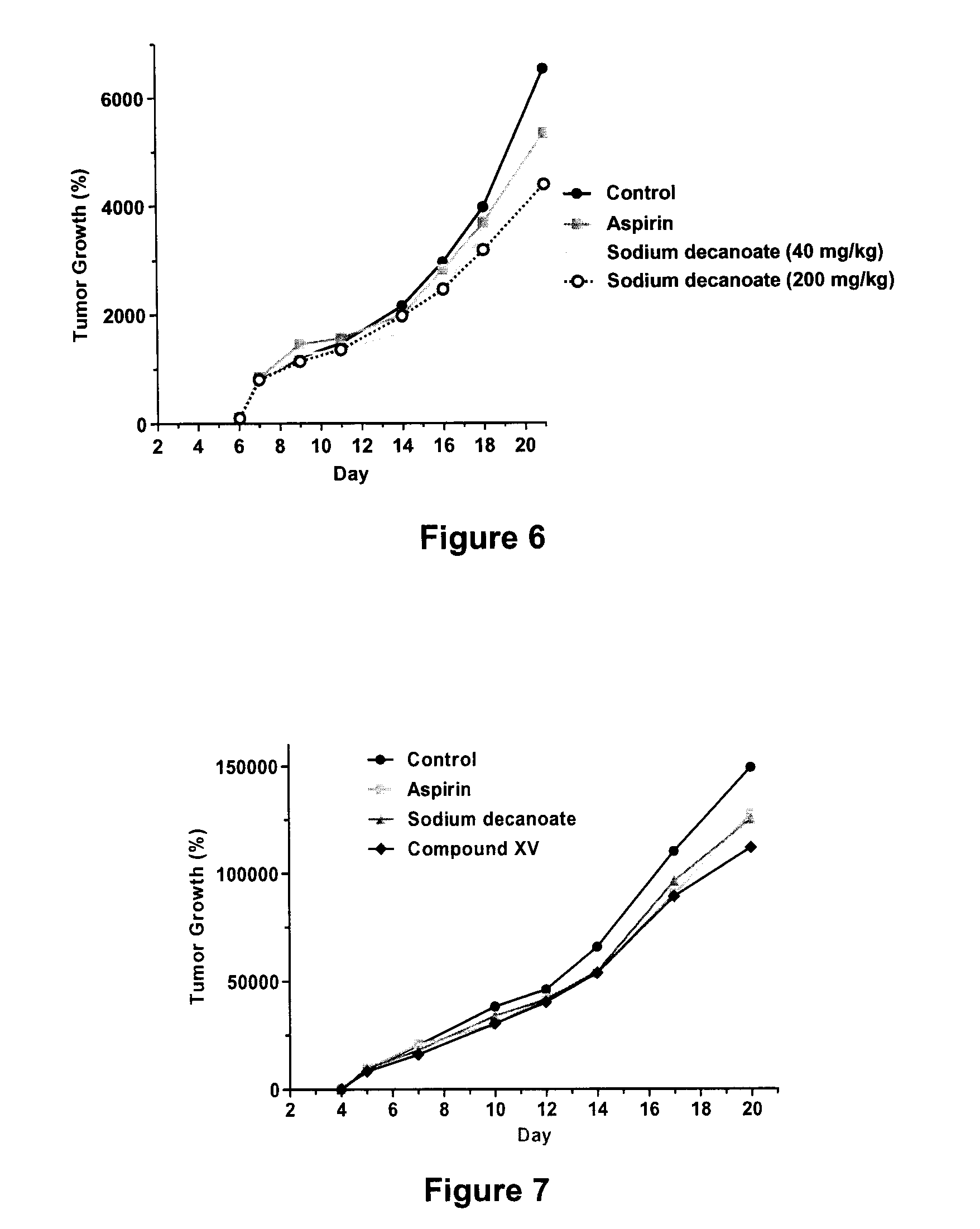Compounds and compositions for the treatment of cancer
a technology of compounds and compositions, applied in the field of medicine, can solve the problems of affecting the survival of cancer patients, cancer that has metastasized often reaches too many places to permit a surgical cure, and the limitations of chemotherapeutic agents, etc., and achieves the effects of stimulating the cytolytic activity of lymphocytes, stimulating the antitumor activity of nk cells, and enhancing il-12 production
- Summary
- Abstract
- Description
- Claims
- Application Information
AI Technical Summary
Benefits of technology
Problems solved by technology
Method used
Image
Examples
example 1
Preparation of Substituted Phenylacetic Acid Compounds
Compound I: Synthesis of sodium salt of (3-pentylphenyl)acetic acid using a modified Sonogashira procedure
[0196]
[0197]Step 1: To a solution / suspension of 3-bromophenylacetic acid (5.02 g, 23.33 mmol) in ethanol (100 mL) at room temperature was added concentrated sulfuric acid (1 mL). The colorless solution was then stirred overnight at 80° C. The solution was concentrated under reduced pressure. The residue was diluted with ethyl acetate (25 mL), water (25 mL) and the two layers were separated. The aqueous layer was extracted with ethyl acetate (2×25 mL) and brine (20 mL). The combinated organic layers were washed with saturated solution of NaHCO3 (2×25 mL), brine (25 mL) and dried over sodium sulfate. After filtration the solution it was evaporated to dryness. This gave a light yellow oil (5.4 g, 95%). 1H-NMR (400 MHz, CDCl3): δ 1.26 (t, J=4.7 Hz, 3H), 3.57 (s, 2H), 4.15 (Q, J=7.0 and 14.3 Hz, 2H), 7.17-7.26 (m, 2H), 7.38-7.44 (...
example 2
Preparation of Substituted Phenylpropionic Acid Compounds
[0226]
Compound XIV, (±)3-(4-[4-methoxyphenyl)methoxy]phenyl)-hex-4-ynoic acid.
[0227]Representative procedure where n=1, Z═—C═C—CH3, X═O and Y=3-O—CH2—C6H5—O—C6H5.
[0228]
[0229]A 2-liter flask was charged with 4-hydroxybenzaldehyde (50 g, 409 mmol) and water (400 mL). The temperature of the reaction was kept at 75° C. and Meldrum's acid (62 g, 430 mmol) was added as a slurry in water (400 mL). The mixture was stirred for 2 h then cooled in an ice bath for 2 h. The product was filtered, rinsed with cold water and dried under vacuum. This gave 5-(4-hydroxybenzylidene)-2,2-dimethyl-[1,3]dioxane-4,6-dione (95 g, 94%) as a yellow solid. 1H NMR (500 MHz) (DMSO-d6) δ 9.75 (br, s, 1H); 8.27 (s, 1H); 8.24 (d, 2H, J=10 Hz); 6.98 (d, 2H, J=10 Hz); 1.76 (s, 6H). MS ESI m / e: 519 (2M+Na). This compound was dissolved in anhydrous tetrahydrofuran (350 mL) and added slowly to a solution of 1-propylmagnesium bromide in tetrahydrofuran (0.5 N, 600 ...
example 3
Preparation of Substituted Octanoyl Phenyl Compounds
Compound XVII, Sodium (RS)-2-[4-octanoylphenoxy]decanoate.
[0234]
[0235]A mixture of 1-[4-hydroxyphenyl]octan-1-one (10.0 g, 45.4 mmol), K2CO3 (9.4 g, 68.1 mmol) and iodine (1.5 g, 9.1 mmol) in acetone (100 mL), was treated with ethyl 2-bromodecanoate (13.9 g, 49.9 mmol), and the reaction was stirred at room temperature, under nitrogen, overnight. Solvent was evaporated in vacuo, and the residue partitioned between ethyl acetate and water. The organic phase was washed with saturated sodium chloride, dried over magnesium sulfate, filtered and evaporated in vacuo. The crude material was purified on a silica gel pad, eluting with 5% ethyl acetate / hexane to give ethyl (RS)-2-[4-octanoylphenoxy]decanoate (11.9 g, 62%) as a colourless oil. 1H NMR (400 MHz, CDCl3): δ 7.92 (d, J=9.0 Hz, 2H), 6.89 (d, J=9.0 Hz, 2H), 4.66 (dd, J=7.5, 5.2 Hz, 1H), 4.21 (q, J=7.0 Hz, 2H), 2.89 (t, J=7.4 Hz, 2H), 1.90-2.03 (m, 2H), 1.66-1.74 (m, 2H), 1.43-1.56 (m...
PUM
| Property | Measurement | Unit |
|---|---|---|
| temperature | aaaaa | aaaaa |
| pH | aaaaa | aaaaa |
| temperature | aaaaa | aaaaa |
Abstract
Description
Claims
Application Information
 Login to View More
Login to View More - R&D
- Intellectual Property
- Life Sciences
- Materials
- Tech Scout
- Unparalleled Data Quality
- Higher Quality Content
- 60% Fewer Hallucinations
Browse by: Latest US Patents, China's latest patents, Technical Efficacy Thesaurus, Application Domain, Technology Topic, Popular Technical Reports.
© 2025 PatSnap. All rights reserved.Legal|Privacy policy|Modern Slavery Act Transparency Statement|Sitemap|About US| Contact US: help@patsnap.com



